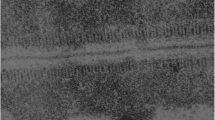Summary
Species of Chilocorus differ in chromosome number owing to centric fusion of metacentric chromosomes. The concomitant loss of arms is tolerated because in all unfused chromosomes one arm is completely heterochromatic, the other euchromatic. Under the influence of colchicine, the arms of unfused and fused chromosomes contract differentially. Unless the distribution of heterochromatin is known, karyotype analysis is destined to failure.
Similar content being viewed by others
Literature
Patau, K.: The identification of individual chromosomes, especially in man. Amer. J. hum. Genet. 12, 250–276 (1960).
Smith, S. G.: Heteropycnosis as a means of diagnosing sex. J. Hered. 36, 194–196 (1945); - The cytogenetic basis of speciation in Coleoptera. Proc. Intern. Congr. Genet., 10th Meeting, Montreal, Canada, 444–450 (1959); - Cytogenetics of insects. Ann. Rev. Entom. 5, 69–84 (1960).
White, M. J. D.: Animal cytology and evolution, 2nd ed. Cambridge: Cambridge University Press 1954.
Author information
Authors and Affiliations
Additional information
Dedicated to Professor H. Bauer on the occasion of his sixtieth birthday.
Contribution No. 1138, Forest Entomology and Pathology Branch, Department of Forestry, Ottawa, Canada.
Rights and permissions
About this article
Cite this article
Smith, S.G. Heterochromatin, colchicine, and karyotype. Chromosoma 16, 162–165 (1965). https://doi.org/10.1007/BF00320946
Received:
Issue Date:
DOI: https://doi.org/10.1007/BF00320946




